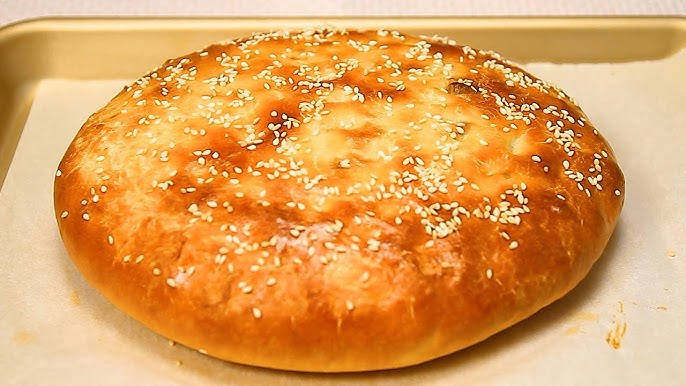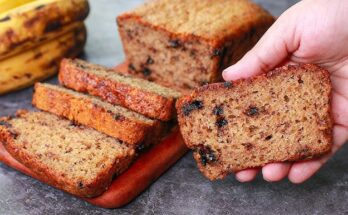Potato Bread Recipe: Who doesn’t love the comforting smell of fresh bread wafting through the kitchen? If you’re looking to take your homemade bread to the next level, potato bread might just be your new favorite. It’s soft, fluffy, and incredibly satisfying.
Let’s dive into how to make the ultimate potato bread at home.
Introduction to Potato Bread
Potato bread is a timeless classic that combines the soft texture of mashed potatoes with the chewiness of traditional bread. Unlike your standard white or whole wheat loaf, potato bread has a slightly sweet, earthy flavor and a unique softness that’s hard to beat.
You might be wondering why we’d even add potatoes to bread in the first place. Well, the starch in potatoes helps retain moisture, making the bread stay fresh longer. Plus, the natural sugars in potatoes contribute to a beautifully browned crust when baked.
But beyond its technical benefits, potato bread brings nostalgia to the table. It’s the kind of recipe that’s often passed down from grandparents, made for Sunday dinners, and enjoyed with butter melting into every warm slice.
Benefits of Using Potatoes in Bread
There’s more to adding potatoes to your dough than just flavor. Let’s break down the benefits:
- Moisture Retention: Potato starch is a moisture magnet. It helps keep your bread from drying out too quickly.
- Longer Freshness: Unlike typical bread that can go stale after a day or two, potato bread stays soft and delicious for days.
- Improved Texture: The potato gives your bread a softer crumb and more tender bite—great for sandwiches or toast.
- Nutritional Boost: Potatoes add a small dose of vitamins like B6 and C, as well as potassium and fiber.
- Versatile Taste: The flavor is neutral enough to go sweet or savory, depending on your preference.
So not only does potato bread taste amazing, but it also stays fresher, longer, and comes with bonus nutritional perks.
Ingredients You’ll Need
Before you get your hands messy, let’s gather everything you’ll need to make this delicious bread.
Main Ingredients:
- 2 medium potatoes (about 1 cup mashed)
- 4 cups all-purpose flour (plus more for kneading)
- 1 packet (2 ¼ tsp) active dry yeast
- ¼ cup sugar
- 1 ½ tsp salt
- ¼ cup unsalted butter (softened)
- ½ cup warm milk
- ½ cup warm water
Optional Add-ins and Variations:
- Garlic powder or herbs for flavor
- Shredded cheese for a richer loaf
- Whole wheat flour for a more hearty texture
- Honey or molasses instead of sugar for a deeper sweetness
Each of these ingredients plays an important role. The potatoes make the bread moist, the yeast helps it rise, the butter adds richness, and the flour creates structure. Don’t skip on any of the essentials if you want a foolproof loaf!
Tools Required for Making Potato Bread
You don’t need fancy equipment to make potato bread, but having the right tools can definitely make the process easier.
Basic Kitchen Tools:
- Large mixing bowl
- Potato masher or fork
- Measuring cups and spoons
- Wooden spoon or spatula
- Clean kitchen towel
Recommended Baking Equipment:
- Stand mixer with dough hook (optional, but helpful)
- Loaf pans or baking sheet
- Oven thermometer (to ensure accurate baking temp)
- Cooling rack (so your bread doesn’t get soggy after baking)
Having your tools ready before you start will help the process flow smoothly, and you’ll avoid scrambling mid-recipe.
Step-by-Step Potato Bread Recipe
Let’s get into the real heart of it—making the bread. Here’s a detailed, step-by-step guide that will help you craft the perfect potato bread, whether it’s your first time baking or your fiftieth.
Step 1: Boil and Mash the Potatoes
Start by peeling and dicing your potatoes. Place them in a pot of boiling water and cook until fork-tender—this usually takes about 10–12 minutes. Once soft, drain and mash them thoroughly. You want smooth mashed potatoes with no chunks.
Let them cool to room temperature. This step is crucial—adding hot potatoes to yeast dough can kill your yeast and ruin the rise.
Step 2: Mix the Dough
In a large bowl, combine the mashed potatoes, sugar, salt, butter, warm milk, and warm water. Stir until well mixed. Then sprinkle in your yeast. Let it sit for about 5 minutes until it gets foamy.
Gradually add flour, one cup at a time, stirring between each addition. Once the dough comes together, transfer it to a floured surface.
Step 3: Knead and Rest
Now it’s time to get your hands in there. Knead the dough for about 8–10 minutes until it becomes smooth and elastic. You can also use a stand mixer with a dough hook for this step if you prefer.
While kneading, you’re developing the gluten—the network of proteins that gives bread its chewy texture. You’ll know it’s ready when the dough is no longer sticky and springs back slightly when pressed.
Once you’re done kneading, shape the dough into a ball. Lightly oil a large bowl and place the dough inside. Turn it once to coat it in oil. This keeps it from drying out during the rise. Cover the bowl with a clean towel or plastic wrap and set it in a warm place to rest.
Let it rise until it doubles in size, usually about 1 to 1.5 hours depending on the temperature in your kitchen.
Step 4: First Rise
This first rise is also called “proofing” and is when the yeast gets to work, producing carbon dioxide that helps the dough expand and develop flavor.
Don’t rush this part. If your kitchen is cool, it might take a bit longer. A good trick? Turn your oven on to its lowest setting for a few minutes, then turn it off. Place your covered bowl inside the warm (but off) oven—it’s the perfect proofing environment.
After the dough has doubled, punch it down gently to release excess gas and prepare for shaping.
Step 5: Shape the Dough
Turn the dough out onto a lightly floured surface. If you’re making loaves, divide the dough into two equal pieces. Shape each piece into a loaf by flattening it into a rectangle and rolling it up tightly from the short side.
Place the shaped loaves into greased loaf pans. If you prefer a more rustic look, shape the whole dough into a round boule and place it on a baking sheet lined with parchment paper.
Shaping evenly is key—uneven dough can rise poorly and bake unevenly. Smooth tops, sealed seams, and uniform size make for better presentation and texture.
Step 6: Second Rise
Once shaped, your dough needs a second rise, also known as “proofing again.” Cover the loaves with a towel and let them sit in a warm area for about 30–45 minutes.
They should nearly double in size again and feel slightly puffy. You can test if they’re ready by gently poking the dough with your finger. If the dent springs back slowly and not completely, it’s go time.
During this time, preheat your oven to 375°F (190°C). A well-preheated oven is essential for a strong oven spring—when the dough expands quickly in the first few minutes of baking.
Step 7: Bake the Bread
Place the loaves in the oven and bake for about 35–40 minutes, or until the tops are golden brown and the bread sounds hollow when tapped on the bottom. If you’re using a thermometer, the internal temperature should read around 190°F (88°C).
For an extra golden crust, you can brush the tops with melted butter as soon as they come out of the oven. Let the bread cool in the pans for about 10 minutes before transferring to a wire rack to cool completely.
Don’t slice too soon—letting it cool helps the structure set, and you’ll avoid a gummy texture inside.
Tips for Perfect Potato Bread
- Use leftover mashed potatoes if they’re not loaded with butter or cream.
- Avoid over-kneading. Too much kneading can lead to a dense loaf.
- Don’t skip the second rise. It helps create the right texture and prevents a heavy bread.
- Check your yeast’s expiration date. Inactive yeast means no rise.
- Add a bit of potato water (water from boiling the potatoes) for extra flavor.
These tips might seem small, but together they make a big difference in your final loaf. Think of baking as part science, part art—and these tricks are your cheat codes.
Storing and Freezing Potato Bread
Homemade potato bread doesn’t just taste better—it also stays fresh longer than regular bread. Still, proper storage can extend its life even more.
Short-Term Storage:
If you plan to eat your bread within 3 to 4 days, wrap it tightly in plastic wrap or aluminum foil and store it at room temperature. You can also place it in an airtight container or bread box to prevent it from drying out.
Avoid storing bread in the refrigerator—it can actually speed up the staling process due to moisture loss.
Freezing Instructions:
Want to keep your bread for longer? Freezing is your best bet.
Here’s how to do it:
- Let the bread cool completely. Never freeze warm bread—it’ll trap condensation and create ice crystals.
- Wrap it tightly. Use a double layer of plastic wrap followed by a layer of foil. This protects against freezer burn.
- Label and date. Bread is best used within 3 months, though it can last longer if stored properly.
- Slice before freezing. If you freeze it pre-sliced, you can pull out just what you need—perfect for quick toast!
To thaw, just leave it at room temperature in the wrap or pop a slice into the toaster. Either way, you’ll get soft, fresh-tasting bread that’s just as good as the day you baked it.
Potato Bread Serving Suggestions
Potato bread is delicious on its own, but there are so many ways to enjoy it that you’ll never get bored. Here are some tasty ideas:
For Breakfast:
- Toasted with butter and jam
- French toast with cinnamon and syrup
- Breakfast sandwich with eggs and cheese
For Lunch:
- Grilled cheese sandwiches—crispy, golden outside, melty cheese inside
- BLTs with thick, hearty slices
- Cold sandwiches with deli meat, lettuce, and tomatoes
For Dinner:
- Soup and bread combo—perfect with creamy tomato or hearty stew
- Side for casseroles or roast chicken
- Garlic toast—just brush with butter, sprinkle garlic powder, and broil
As a Snack:
- Slathered with peanut butter or Nutella
- Cut into cubes and toasted for homemade croutons
- Turned into mini pizzas with sauce and cheese
Whether you’re enjoying it warm with a pat of butter or using it to elevate your sandwich game, potato bread brings comfort to every bite. It’s the kind of food that makes a meal feel homemade, even on a busy day.
FAQs about Potato Bread Recipe
1. Can I use instant mashed potatoes instead of fresh?
Yes, you can use instant mashed potatoes, but make sure they’re plain with no added butter or milk. Use about 1 cup of prepared instant mash.
2. Why didn’t my bread rise properly?
Your yeast might be expired, or your liquids might have been too hot and killed the yeast. Always let your dough rise in a warm, draft-free place.
3. How long does homemade potato bread last?
At room temperature, it lasts about 4–5 days when stored properly. You can freeze it for up to 3 months.
4. Can I use whole wheat flour instead of white flour?
Yes, but start by replacing only half the flour with whole wheat to maintain a soft texture. Whole wheat can make the loaf denser.
5. What’s the best way to reheat potato bread?
For slices, pop them in a toaster. For whole loaves, wrap in foil and warm in the oven at 300°F (150°C) for 10–15 minutes.
Conclusion
Potato bread is more than just a twist on traditional bread—it’s a delicious, nostalgic, and versatile addition to your kitchen. From its tender texture to its rich flavor, it’s a loaf that wins hearts with every slice. With just a few ingredients and some time, you can create something truly special that your family will ask for again and again.
And the best part? Once you’ve mastered the basic recipe, the possibilities are endless. Add herbs, mix in cheese, or shape it however you like. Baking potato bread is both an art and a comfort, giving you not only nourishment but the joy of creating something from scratch.
So go ahead—roll up your sleeves and bake your first loaf of potato bread. You’ll never look at store-bought the same way again.



